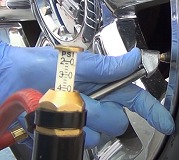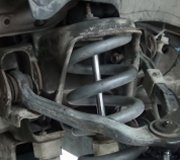Humming that sounds like an airplane engine is usually a front wheel bearing. On older cars, the noise will change when you turn a little, similar to changing lanes. If you turn slightly to the left and the noise becomes real quiet, it's the left front wheel bearing. By turning, vehicle weight shifts to the other side of the car. If the noise gets louder when you turn left, it's the right front bearing.
Your car uses a bolt-on type wheel bearing. They're more expensive than the older pressed-in bearings from the 1980s, but easier to replace. The problem with these bolt-on bearings is you can not be sure which one is bad. Turning slightly might affect the sound, and you might think it's coming from a specific side of the car, but you have a 50 / 50 chance of being wrong. The only way to tell for sure is to run the car in gear while the front is jacked up, and listen next to each front wheel with a stethoscope. One will sound noisy, ... And the other one will sound REAL noisy. With the older pressed-in bearings, you had to destroy them to remove them, but there was never a need to replace them unless they were noisy. The advantage to your style is if you replace the wrong one, you can put the old one on the other side of the car. You can also find good used ones in the salvage yards.
One important note. You'll need to remove the axle nut before you slide the bearing assembly off the car. If the vehicle's weight is supported by the bearing at any time when that nut is loose, the bearing will become noisy. The easiest way to loosen the nut is to jack up the corner of the car, remove the wheel, then stick a big screwdriver in one of the brake rotor's vent holes to prevent the axle from turning when you loosen and tighten the nut. The nut calls for a very high torque spec, and it's important that it be tightened the proper amount. Use a click-type torque wrench for accuracy. Typical values are between 150 to 240 foot pounds.
Caradiodoc
Tuesday, June 23rd, 2009 AT 6:42 PM


